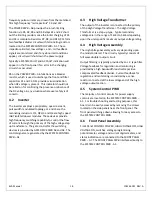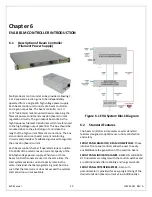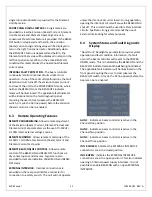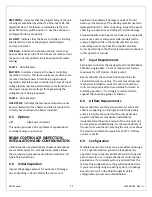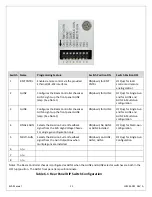
EVA
Manual
8
118144
‐
001
REV.
A
in
approximately
6
seconds
after
the
HIGH
VOLTAGE
ON
switch
is
depressed.
K)
To
terminate
the
generation
of
output
power,
depress
the
HIGH
VOLTAGE
OFF
switch.
In
the
HIGH
VOLTAGE
OFF
mode
the
power
supply’s
fault
and
interface
circuits
are
still
active.
L)
To
turn
off
the
power
supply,
depress
the
amber
CONTROL
POWER
ON
switch
to
release
the
switch
bezel
to
the
out
position.
All
front
panel
lights
should
extinguish.
NOTE
:
If
a
power
supply
fault,
or
system
monitoring
fault
occurs,
the
power
supply
will
revert
to
the
POWER
DOWN
mode.
In
this
mode
the
output
power
will
be
turned
off.
The
CONTROL
POWER
ON
lamp
will
flash
indicating
a
SYSTEM
FAULT.
To
reset
the
SYSTEM
FAULT
cycle
the
CONTROL
POWER
ON
switch,
cycle
the
AC
line
power
or
toggle
the
RESET/EXTERNAL
INHIBIT
signal
line.
WARNING
AFTER
TURNOFF,
DO
NOT
HANDLE
THE
LOAD
UNTIL
THE
CAPACITANCE
HAS
BEEN
DISCHARGED!
LOAD
CAPACITANCE
MAY
BE
DISCHARGED
BY
SHORTING
TO
GROUND.
WARNING
THE
VOLTMETER
ON
THE
POWER
SUPPLY
FRONT
PANEL
DOES
NOT
READ
THE
OUTPUT
VOLTAGE
WHEN
THE
POWER
IS
TURNED
OFF,
EVEN
IF
A
CHARGE
STILL
EXISTS
ON
THE
LOAD.
CAUTION
TO
ASSURE
SAFETY
AND
PROPER
COOLING
ALWAYS
OPERATE
THE
UNIT
WITH
THE
COVER
PANELS
INSTALLED.
Internal
fans
maintain
safe
operating
temperatures
in
the
power
supply
by
drawing
air
over
the
circuit
components.
The
covers
must
be
on
in
order
to
direct
the
air
flow
over
the
areas
that
need
cooling.
In
operation,
the
units
air
intake
and
fan
exhaust
paths
must
be
clear
of
any
obstructions
that
might
impede
the
flow
of
air.
3.2
Standard
Features
A
general
note
on
remote
interface
circuitry
and
remote
signal
grounding:
When
usage
applications
dictate,
electrical
isolation
may
be
required
when
interfacing
with
the
high
voltage
power
supply
in
question.
For
power
control
signals
such
as
CONTROL
POWER,
EXTERNAL
INTERLOCK,
HIGH
VOLTAGE
OFF
and
HIGH
VOLTAGE
ON
isolated
relay
contacts
should
be
used.
For
status
signals
and
control
signals
such
as
HIGH
VOLTAGE
ON
status,
HIGH
VOLTAGE
OFF
status,
EXTERNAL
INHIBIT,
etc.
opto
‐
isolation
should
be
used.
When
usage
applications
dictate,
analog
programming
and
monitoring
signals
may
require
isolation
via
analog
isolation
amplifiers.
All
interface
cables
should
be
properly
shielded.
All
power
supply
signals
should
be
referenced
to
the
power
supplies
signal
ground
on
the
rear
panel
interface
connecter.
LOCAL/REMOTE
PROGRAMMING
:
Allows
adjustment
of
the
output
voltage
and
current
via
the
front
panel/internal
controls
(local)
or
external
voltage
sources
(remote).
LOCAL
CONTROL
‐
In
local
control
(front
panel
control),
jumpers
are
installed
on
rear
panel
interface
connector
between
pin
8
and
pin
9
for
current
control
and
between
pin
10
and
pin
11
for
voltage
control.
This
will
enable
the
front
panel
potentiometer
for
voltage
control
and
an
internal
pull
up
for
current
control.
REMOTE
CONTROL
‐
For
remote
programming,
the
above
mentioned
jumpers
are
removed
and
a
positive
polarity,
ground
referenced
voltage
source
is
applied
to
the
pin
8
for
current
and
pin
10
for
voltage.
Programming
signals
should
be
referenced
to
pin
1,
signal
ground.
Scaling
is
such
that
0
‐
10Vdc
corresponds
to
0
‐
100%
rated
output
respectively.
See
Figure
3.2A
for
wiring
diagram.
An
alternate
method
of
controlling
the
output
remotely
is
by
using
external
resistance
such
as
a
potentiometer
or
a
resistor
network.
For
remote
control
the
jumpers
are
removed
and
the
desired
resistor
configuration
is
installed.
See
Figure
3.2B
for
wiring
diagram.

























